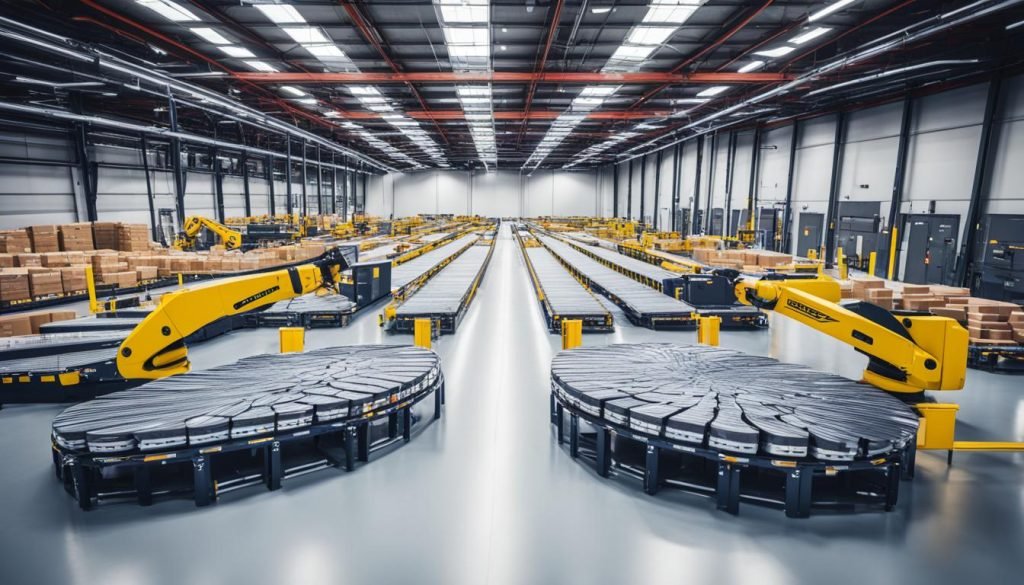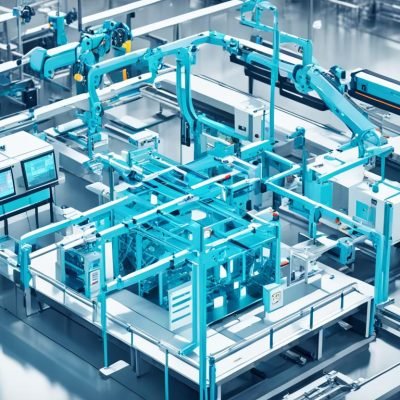Today, quick and effective transportation and warehousing are critical. They ensure supply chains run smoothly. By managing inventory well and making work more efficient, businesses can meet customer needs.
At [Your Company Name], we know how important logistics are. We help with inventory control, warehouse operations, distribution, and shipping. Our services aim to make your supply chain, transport, and logistics operations better.
By looking at how things are done now, using lean methods, and new tech, businesses can tackle inventory issues. We’ll create solutions just for you. They’ll make your work better and meet your goals.
Our solutions mean better inventory, shipping, and warehouse work. This will boost your supply chain and make you stand out in your market.
Key Takeaways:
- Streamlining warehousing and logistics processes is vital for businesses to overcome inventory management challenges.
- Analyzing current processes, optimizing inventory management, implementing lean principles, improving communication, and leveraging automation and technology are key strategies for streamlining operations.
- Efficient transportation and warehousing are crucial for businesses to meet customer expectations and enhance supply chain management.
- [Your Company Name] offers comprehensive logistics solutions that optimize inventory management, transportation services, and warehouse operations.
- Our team of experts will work closely with you to develop tailored solutions that improve operational efficiency and give you a competitive advantage.
Analyzing Current Warehousing and Logistics Processes
Before making your warehousing and logistics better, check how they work now. Look for places where you could do better. This helps you make changes focused on improvement.
Gathering data on inventory management, order cycle time, and order accuracy starts the analysis. Checking these can show what’s not working well and where you can improve.
Creating maps of your processes is key. It shows what tasks you do and how they’re connected. Ways to improve become clear this way.
You’ll plan changes for your logistics and warehousing based on what you need. This could mean updating systems or changing how your warehouse is laid out. It might also involve using new inventory systems or considering third parties for help.
Example of Process Mapping for Warehouse Layout
| Metrics | Definition |
|---|---|
| Inventory Management | The process of efficiently tracking, controlling, and optimizing inventory levels to ensure proper stock availability and avoid excessive or insufficient quantities. |
| Order Cycle Time | The time it takes for an order to be placed, processed, fulfilled, and delivered to the customer, including all stages of the order fulfillment process. |
| Order Accuracy | The degree to which the items and quantities ordered by customers match the actual items and quantities delivered. High order accuracy minimizes errors and customer dissatisfaction. |
| Process Mapping | A visual representation of the sequence of activities, handoffs, and decision points involved in a specific process, helping to identify inefficiencies and opportunities for improvement. |
| Warehouse Layout | The physical arrangement and optimization of storage areas, picking aisles, packing stations, and other components within a warehouse to facilitate efficient movement of goods. |
| Inventory Systems | The software and tools used to manage and control inventory, including tracking stock levels, monitoring sales, forecasting demand, and automating replenishment. |
| Technology | The implementation of advanced digital tools, such as warehouse management systems, barcode scanning, RFID tracking, and automation solutions, to streamline operations and improve productivity. |
| Third-Party Logistics | The outsourcing of logistics functions and activities to specialized external providers, allowing businesses to focus on their core competencies while leveraging the expertise and resources of a logistics partner. |
After looking closely at how things are going now, aim for changes that make sense. This can cut costs and make customers happier. Next, learn about ways to make the whole supply chain better.
Streamlining Warehousing and Logistics Processes
Managing inventory well is key to improving warehouse and logistics tasks. By using smart inventory plans, companies can stop running out of products or having too many. They can also cut down on costs. To do this, companies should use lean methods, improve teamwork, and welcome new technology.
Optimize Inventory Management
Using special software, doing checks often, and timing when you get new stock are all ways to run a tight ship with your products. Inventory software shows you exactly what you have, so you order wisely. Checking your stock often finds problems and keeps counts right. And only getting new stock right when you need it keeps extra costs down.
Implement Lean Principles
Lean thinking is about cutting out waste and making things move smoother in the warehouse or with deliveries. Methods like Kaizen and 5S help businesses spot and get rid of things that don’t add value. This makes the process more efficient. Lean also focuses on improving the order of how things are done and making things happen faster without mistakes.
Improve Communication and Collaboration
Good talk and working together across teams are crucial for a streamlined supply chain. Open and clear communication helps teams work better together. It cuts down on mistakes and speeds things up. Sharing info, having the same goals, and tackling issues together make everything run more smoothly.
Embrace Automation
Tools like barcode scanners and robots are a big help in making storage and shipping better. Barcode scanning stops mistakes in tracking stock by hand. Robots help with jobs like packaging, cutting costs, and upping efficiency. Using these tools cuts down on mistakes, boosts how well things run, and lets companies use their people better.
By handling inventory better, using lean ideas, working together well, and adding new tech, companies can make warehouses and logistics work smoother. This helps save money, work better, and keep customers happy in a tough market.

| Benefits of Streamlining Warehousing and Logistics Processes | Key Strategies |
|---|---|
| Minimized stockouts and overstocking | Optimize inventory management |
| Reduced waste and increased efficiency | Implement lean principles |
| Improved coordination and reduced lead times | Improve communication and collaboration |
| Decreased labor costs and minimized errors | Embrace automation |
Automating Warehousing and Logistics Processes
Automation is changing the game in today’s quick business world. It has a big impact on how warehouses and logistics work. By using automated tools, companies can make fewer mistakes, do better work faster, and spend less. Everything from keeping track of products to sending them out is getting a tech upgrade.
Automated Inventory Management
Keeping track of what you have is a big deal now, thanks to automation. It uses smart math and up-to-the-minute info to watch your stock. This means you always know what’s running low or too high. It’s a big deal for making sure your customers get what they need without waiting.
Automated Order Processing
Remember the slow, mistake-filled days of handling orders by hand? They’re over. Now, with automated systems, businesses can speed up how they get orders out. These systems do tasks like checking orders and updating info way faster and with fewer errors. This improves how happy your customers are and how you use your time and money.
Automated Shipping and Logistics
Shipping and getting things where they need to be has never been smoother. These new systems use things like GPS and quick talking between devices to get orders out easily. They cut down on late deliveries, wrong orders, and costs for you. Also, they make sure everyone working on the order is always in the loop.
Robotics and Automation
Robots are a big part of how warehouses and moving things around are changing. They do the boring or heavy lifting things so humans can do smarter work. It picks up the pace, keeps everyone happy, and makes your warehouse safer.
To sum up, automation is shaking up how we do warehousing and moving things. With the latest in keeping tabs on what you’ve got, sending orders out, and using robots, businesses can run smoother. This makes customers happier and sets you up for winning in the future.
Leveraging Technology to Optimize Warehousing and Logistics Processes
In today’s world, technology is key for businesses wanting to make their warehousing and logistics better. Two top technologies for this are data analytics and cloud computing.
Data analytics give insight to improve how much inventory we have and make orders faster. By looking at data on what sells, what people want, and how much they buy, decisions become smarter. This makes forecasting demand more accurate. It helps lower the times we’re out of stock, cuts unused stock, and makes customers happier.
Cloud computing offers businesses with more than one spot a way to work together better. It allows easy sharing of info and talks between different places. Using cloud services, businesses sync their data. So they see what sells, what’s ordered, and what’s shipped as it happens. This simplicity means working better together, being more efficient, and making smarter choices.
“Data analytics tools provide businesses with valuable insights that help improve inventory levels and enhance order fulfillment times.”
Cloud technology also lets companies use automation and AI to their advantage. With the cloud, companies can use the best in warehouse and transport management systems. These systems keep an eye on stock, process orders, and set up shipments automatically. It means fewer mistakes, quicker service, and smarter use of resources.
One way to make warehousing and logistics better is by using predictive analytics. This means looking at the past to guess the future. When you use machines to help, they can tell when we’ll need more of something before we run out. This smart planning means less cost, no items missing, and a more efficient operation.
| Data Analytics | Cloud Computing |
|---|---|
| Enables better inventory management through data-driven insights | Offers flexibility and scalability for businesses operating in multiple locations |
| Improves order fulfillment times through accurate demand forecasting | Streamlines operations and enhances collaboration |
| Optimizes resource allocation through automation and AI technologies | Provides real-time visibility of inventory, orders, and shipments |
In the end, using data analytics and cloud computing is vital to making warehousing and logistics run smoothly. These technologies make supply chains work better, faster, and at a lower cost. For businesses to keep up in the fast-moving world of commerce, they must adopt these tools.
Conclusion
Good logistics solutions are key for companies aiming to improve how they move and store goods. By making operations more efficient, firms can tackle problems, make their order process better, and have a smooth supply chain.
The first step to make things better is to look at how things are done now. Companies should find spots for getting better, like managing stock well, making orders faster, and getting orders right more often. They can use lean principles and machines to help make this happen.
It’s really important for departments to talk with each other and work together well. This makes it easier to coordinate and cut down on how long things take. This helps companies deliver goods to customers quickly and efficiently.
Using the right technology is also critical. Tools that look at data help manage stock better. Cloud services make it easier to grow and change, especially if a company has more than one spot.
To sum up, with the right review, the use of smart practices, and the latest technology, companies can boost their logistics. Doing this means happier customers and a leaner supply chain. It’s all about using the best tools and methods available.
FAQ
How can streamlining warehousing and logistics processes benefit my business?
What are the key strategies for streamlining warehousing and logistics processes?
How can I analyze my current warehousing and logistics processes?
What are some ways to optimize inventory management?
How can lean principles enhance warehousing and logistics processes?
How can automation improve warehousing and logistics processes?
How does technology play a role in optimizing warehousing and logistics processes?
Source Links
- https://www.smartwarehousing.com/blog/streamlining-your-warehouse-logistics-how-smart-warehousing-can-help
- https://www.maersk.com/news/articles/2023/06/26/streamlining-your-logistics-role-of-effective-warehousing
- https://www.linkedin.com/pulse/how-streamline-your-warehousing-logistics-processes-more-efficient




